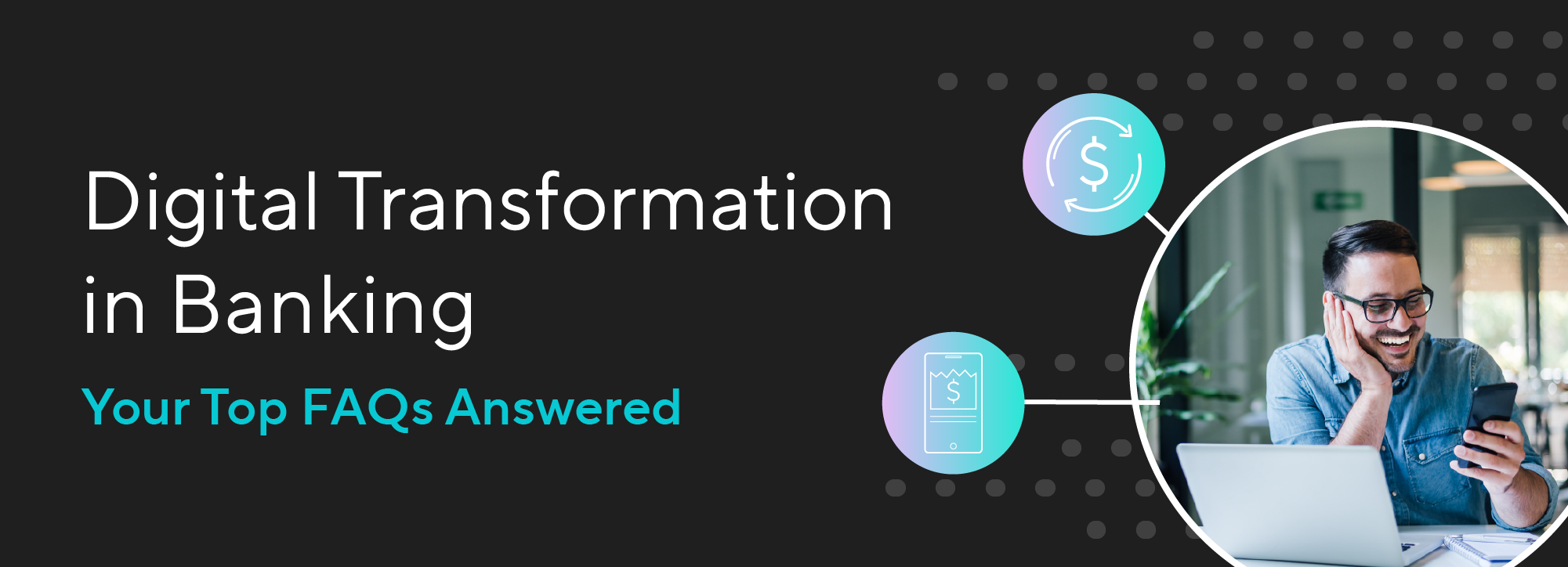Digital Transformation in Banking: Your Top FAQs Answered


Digital transformation is reshaping the banking industry, especially for credit unions and smaller national banks expanding their consumer credit and small business loan offerings. Transitioning to digital applications empowers underwriting teams, streamlines routine data entry tasks, and even enhances the in-branch experience. Talk of digital transformation is everywhere, but buyers can still struggle to envision what the process will look like for them. Inspired by conversations with hundreds of Amount customers, we’ve answered some of the most popular questions financial institutions have when starting their digital transformation journeys.
Q: What are the benefits of digital transformation for banks, and how do I set my organization up for success?
A: We cover the strategic and operational benefits and the basics of initiating digital transformation plans in our latest ebook. Read The Beginner's Guide to Digital Transformation in Banking to find out!
Q: Should I focus on buying or building digital applications?
A: If the decision to buy vs. build is affecting your digital transformation strategy, we’re guessing you’re a larger bank. Large institutions tend to want to maintain as much control as possible over their technical infrastructure and fraud prevention measures. They also want to make good use of the IT talent they’ve already invested in. While it’s true that outsourcing technical services introduces some degree of risk, building digital applications from scratch may not always be the most cost-effective solution. And a bank need not overhaul its internal resources completely to take advantage of cutting-edge tech vendors.
The real strategy lies in combining buying and building. In this approach, IT departments focus primarily on maintaining network governance, enabling communication, and automating routine tasks. The bank then embraces strategic partnerships to address technical gaps so it can quickly bring customer-centric solutions to market without compromising existing infrastructure.
Q: How can digital transformation support the in-branch customer experience?
A: Don’t let the name fool you — the benefits of digital transformation don’t just apply to online interactions. Digital origination platforms, for example, enhance in-branch interactions by providing an omnichannel approach, which means applications can be accessed in-branch, over the phone, or through digital channels. This flexibility allows bankers to use tablets or monitors to facilitate smooth customer interactions, perhaps picking up the process in person wherever the user left off online. Whether entering information themselves or handing over the keyboard to the customer, digital interfaces improve the efficiency and convenience of the in-branch experience.
Despite the transition away from brick-and-mortar banking, branches remain valuable, especially depending on their geographic location and customer demographics. Customers who visit branches tend to be more loyal, engaging with a wider range of products and valuing personal interactions with bank staff. These sticky customers are essential for maintaining a stable customer base. So, while digital applications streamline the omnichannel banking experience, they’re designed to complement rather than replace the in-branch model.
Q: Digital banking expands the vector for cybersecurity threats. How do digital banking applications address our fraud and security concerns?
A: Digital applications can improve your security posture by implementing strong fraud prevention measures. These technologies can include multiple third-party solutions to tackle fraud at the point of account origination, including advanced encryption, multi-factor authentication, continuous monitoring for potential threats, and risk segmentation models that identify potential fraud before it occurs. Additionally, sophisticated platforms may use AI-powered identity verification that uses selfies and real-time data checks to ensure applicant authenticity.
Q: Can digital origination platforms handle document management and compliance?
A: Yes, digital origination platforms can generate and distribute compliant documents using certified templates. These platforms are especially helpful for smaller banks that lack in-house compliance teams, ensuring all documentation meets regulatory standards.
Q: What are the challenges of integrating digital platforms with existing banking systems?
A: Integrating digital platforms with existing banking systems can be challenging due to compatibility issues and the complexity of legacy core systems. Financial institutions should question potential partners on whether their platforms are API-enabled solutions. The platform should be capable of using APIs to facilitate real-time transactions and seamless data synchronization between the digital solutions and the bank’s core systems. Smart digital banking solution buyers will seek partners with extensive experience in integrating with various core systems.
Q: How do digital decisioning solutions impact small-dollar loan profitability?
A: Automating the decisioning process for small-dollar loans significantly improves profitability. Manual underwriting for these loans is cost-intensive, and automation helps reduce these costs. Banks can scale their small business lending operations without increasing their workforce, ensuring higher returns on assets.
Q: Will adopting automated banking solutions result in a reduction in staff?
A: The goal of digital transformation isn’t to reduce staff but to optimize the value of human intervention. Many banks use digital transformation as an opportunity to grow their business without additional hires. By automating routine tasks like data entry, document verification, and mundane customer inquiries, digital origination and decisioning platforms allow financial institutions to reallocate their workforce to more complex or nuanced tasks.
Conclusion
Digital transformation does much more than just streamline operations — it deepens customer relationships and drives innovation. Instead of spending hours processing applications and chasing documents, bankers can guide customers through user-friendly digital applications and spend more time giving them personal finance advice. This shift lets employees focus on tasks where their expertise truly matters, enhancing customer service and satisfaction in turn. When banks embrace both their in-house capabilities and strategic vendor partnerships, they create enriched, user-friendly experiences for everyone involved.

Learn how to define a clear vision and strategy for your financial institution's digital transformation by downloading our ebook, The Beginner's Guide to Digital Transformation in Banking.
 Download Report
Download Report